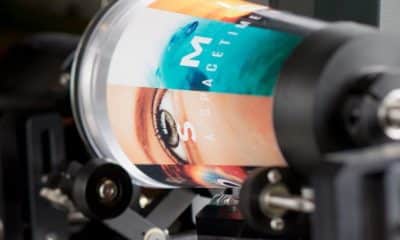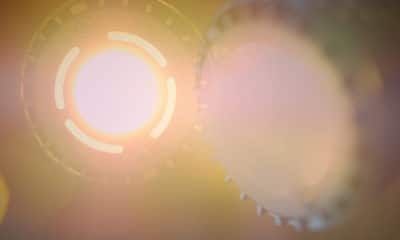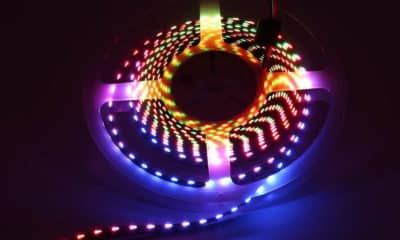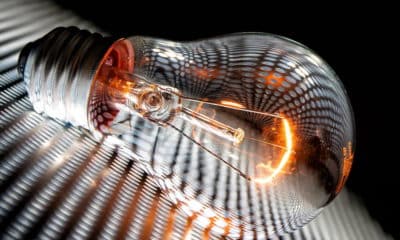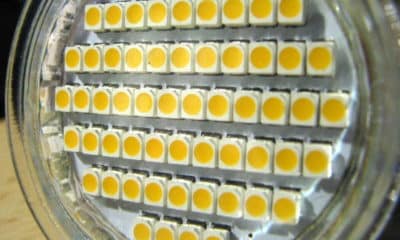Home accessories
The most common light bulb types and differences

Talking about light bulb types, people mostly know these four types. The most common bulb types are LED bulbs, incandescent bulbs, halogen, and CFL bulbs.
We are going to explain each bulb type and write a short review on each. Reading this post, you can understand the difference between these bulbs and find out which one you prefer. Learn how does bulb works, what is Watt, and what light bulb is most efficient?
We’ve all seen so many bulbs in stores, in different shapes and types. We have them in our homes, without even know how each bulb works and how efficient it really is. Now we are gonna learn about bulbs, and find out what are the differences between bulb types.
We are going to explain four basic bulb types.
Regardless of the bulb type, each has its own pros and cons. Let’s see what are they.
There are four basic kinds of light bulbs we know today. Mostly you will find LED, incandescent, halogen, and CFL light bulbs.
Let’s explain the differences in terms of aesthetics and energy usage.
Light bulbs differences
We are going to explain how each bulb type works, and what are the differences. Also, you can read about each bulb energy efficiency.
How does an LED bulb work?
LED stands for (Light Emitting Diode) which means that LED has semiconductor material inside, to produce light. These light bulbs can produce light up to 90% more efficiently than incandescent light bulbs. LED works in a way that an electrical current passes through a microchip, (semiconductor material) which illuminates the tiny light sources. In a LED bulb we have more than just one semiconductor piece, in which way one LED bulb can deliver enough Lumens we need. LEDs are made in a way to dispose of the heat. Preventing performance issues with a heat sink and specially designed electronic circuits LED bulbs can last much longer than regular light bulbs.
The lifetime of the LED bulbs is defined differently than other light bulb types. LEDs typically do not “burn out” or fail. Instead, LED’s experience “lumen depreciation”, or dimming effect. That means that the brightness of the LED comes with a dimming effect slowly over time. Unlike incandescent bulbs, LED “lifetime” is established on a prediction of when the light output decreases by 30 percent.
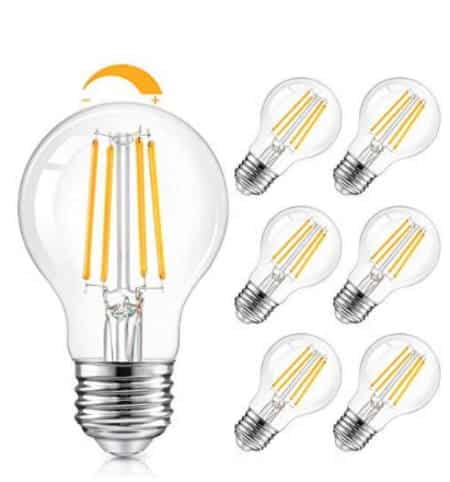
LED A19 Dimmable Light Bulbs 100W Equivalent. Look at these vintage E26 Edison Bulbs 8W 1200LM, 2700K Soft Warm White. The best clear antique LED bulb for home, bathroom, indoor and outdoor. Check the price on Amazon. Omnidirectional Lighting design is awesome and comes in handy with a 360° bean angle. This dimmable A19 LED bulb 100W emits super cozy evenly 2700K warm white lighting without any dark space, perfect for bars, malls, restaurant, showrooms, bedroom, clubs, dining room, showcase, art rooms
LED bulbs last much more than other light bulb types. LED’s are eco friendly, and super energy efficient.
A typical 40W equivalent LED light bulb uses just 6 Watts of electricity to produce 450 lumens. That’s nearly 75 lumens per watt.
LED’s efficiency: These bulbs are at least 75% more efficient than standard incandescent light bulbs. They may come as dimmable and LED smart bulbs. When you buy a LED bulb, you can choose a wide variety of light colors and high color rendering (80-90 CRI). The average life cycle of a LED bulb is about 25,000 hours. This depends on quality and usage. LED bulbs are mostly used light bulbs outdoor, indoor, and decorative purposes bulbs. LEDs are common to light in a garage – read comparison of a Garage LED lights.
Incandescent bulbs usage
We are all familiar with incandescent light bulbs. For the last decade, these light bulbs were most common in our homes and apartments. They cast warm light and a lot of heat. To be more precise, a regular incandescent bulb delivers 20% of light and 80% of heat. That is the reason why they are not efficient. Another reason why we want to avoid using these light bulbs is that they don’t last long.
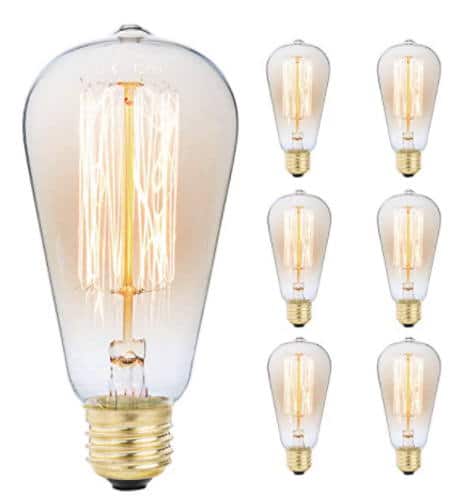
Edison light bulb comes with Antique Vintage design. Take a look at these styled light bulbs, delivering amber warm light. This is a dimmable (60W/110V) incandescent filament bulb. Design is based on Thomas Edison’s original filament bulb, it’ll be your most beloved vintage antique lighting. Incandescent filament bulbs are great for accent lighting. The dimmable effect will bring you the most of them, ensuring the best adjustment to each room. Bulbs are 2.6 inches and will offer more than 30000 hours bulb life, at least 2.7 years based on a 3-hour daily use. Check the price on Amazon.
If you are using these light bulbs, you are aware of how often they need to be replaced. Still, sometimes they are more preferable than the other light bulb types are. You can use an incandescent light bulb when you want a cozier effect or want to get the true colors in a room.
Incandescent light bulbs produce the least amount of lumens per watt. On average, this wire filament bulb delivers only 10 to 17 lumens per Watt.
How efficient is a halogen bulb?
Halogen bulbs are more efficient than incandescent bulbs. This type of light bulbs delivers 25-30% more light than a regular light bulb with the same amount of energy.
Halogen lights deliver 12 to 15 lumen per Watt
However, the halogen bulb emits a whiter light, which is the reason why they mostly are used in offices, kitchens, and outdoors. While delivering light, these bulbs are producing a lot of heat. You can’t use them in a space where the low temperature is demand.
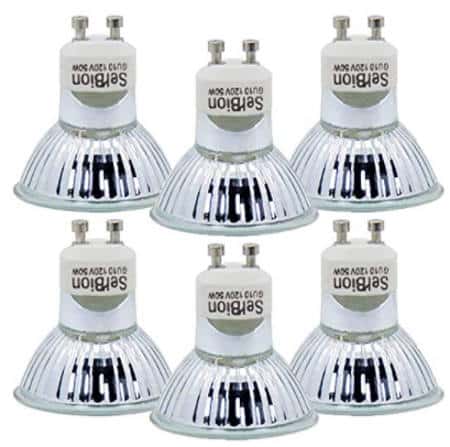
GU10 Halogen light bulb for indoor use. These bulbs are MR16 compliance 50W and 150V. They come with a glass cover, bringing you a dimmable feature. Max light output is 500 lumens with a warm white light color. High-Efficiency Halogen Flood Light Bulbs for Indoor use. You can use them on which high light output from small fixtures, like track lighting, over the range hood, small recessed cans, and outdoor lighting with waterproof protection. Check the price on Amazon.
Halogen is efficient more than a regular incandescent light bulb is. LED is still a better choice if you are looking for efficiency. Halogen bulbs work in a similar principle to incandescent lighting with some main differences. Just like incandescent bulbs, halogen bulbs are using the wire filament. This way, dispersing the heat, halogen gas starts to glow – emitting the light. Compared to a regular incandescent light bulb, a halogen bulb is at least 25% more efficient. This bulb type is fully dimmable. Average life is around 1,000 hours, depending on usage and bulb shape. Halogen bulbs are mostly used for accent, undercabinet, and mini pendants.
CFL bulbs efficiency
CFL light bulbs are more efficient than standard incandescent light bulbs are. You can buy these in the spiral or traditional shape. CFL bulbs last much longer than a regular bulb, and they use less energy for the same amount of Lumens.
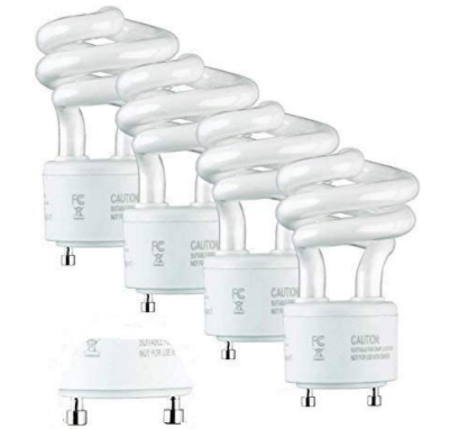
These CFL light bulbs are delivering 50 to 100 lumens to brighten your surroundings. Use these while you are reading at night without strain your eyes. Keep your home energy-efficient with these CFL bulbs. Using these, you use 25-85% less energy comparing your cost if using regular wire filament bulbs. Just by replacing your incandescent bulbs, you save your money. Check the price on Amazon.
A disadvantage for some could be the fact that CFL emits a cold light, just like halogen bulbs do. These bulbs contain mercury, which is why you need to be careful while handling or disposing of the CFL bulbs.
Compact fluorescent lamps (CFL bulbs) emit 40 to 70 lumens per Watt, and high-pressure sodium produces 50 to 140 lumen per Watt.
CFL stands for “Compact Fluorescent” representing energy-efficient bulbs with a wide variety of light colors. They are 75% efficient than regular bulls are.
The average lifetime is around 8,000 hours, depending on usage and bulb shape. CFL bulbs are mostly used for indoor home lightning, and for commercial spaces.
-

 Gadgets6 months ago
Gadgets6 months agoCan Dogs Use VR Headsets?
-

 Tech6 months ago
Tech6 months agoWhat Does “Voicemail Pending” Mean?
-

 Phones5 months ago
Phones5 months agoHow Do I Know if My Phone Supports AR?
-

 Tech5 months ago
Tech5 months agoDoes Astigmatism Affect Your VR Experience?
-

 Business5 months ago
Business5 months agoHow Do You Make an AR Without Coding?
-

 Phones5 months ago
Phones5 months agoWhat To Do About That Weird Notification Sound on Android?
-

 Tech4 months ago
Tech4 months agoHow Can I Get Google Drive 1TB for Free?
-

 Phones4 months ago
Phones4 months agoHow Does SnapDrop Work? – Instant File Sharing Made Easy

